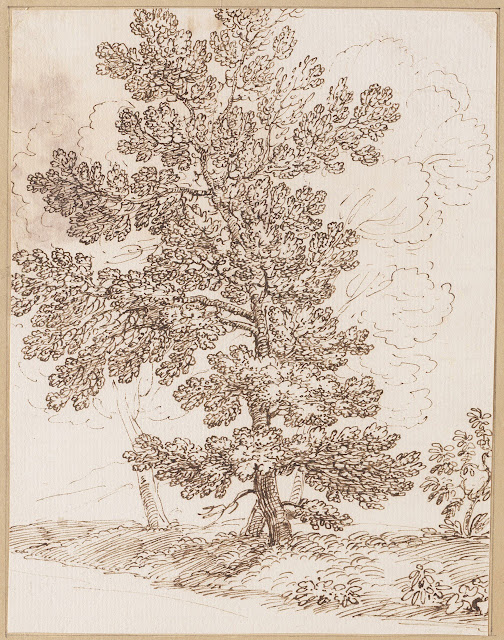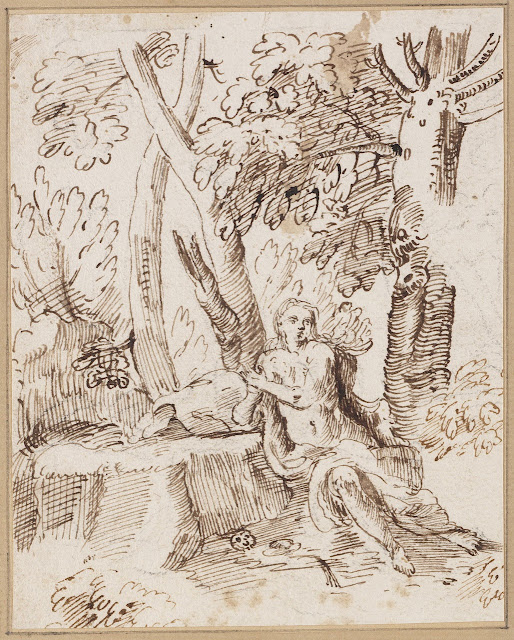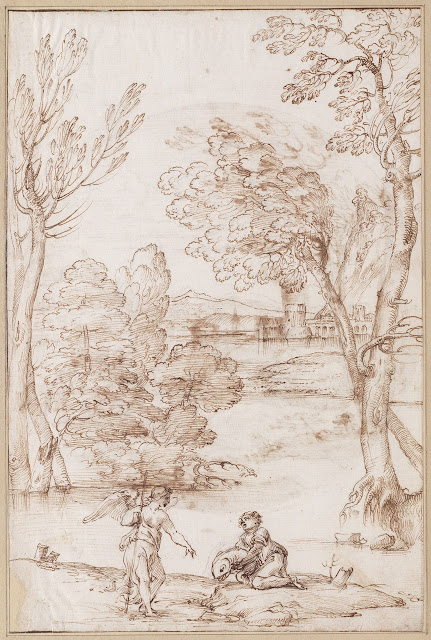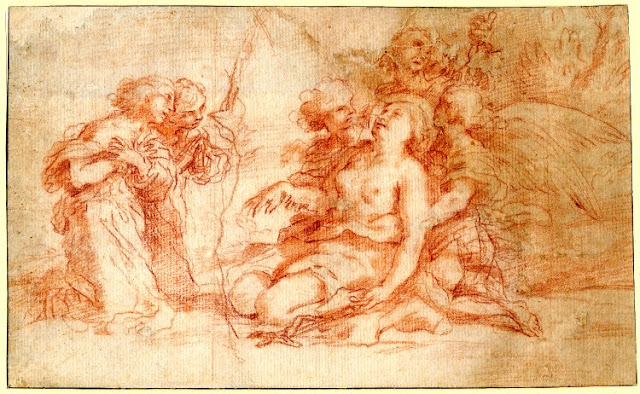 |
| Crescenzio Onofri Group of trees second half of the 17th century drawing Teylers Museum, Haarlem |
 |
| Crescenzio Onofri Landscape second half of the 17th century drawing British Museum |
"Crescenzio Onofri – Landscape painter and etcher, born Rome ca. 1632, died Florence ca. 1712. He was a pupil of the landscape painter Gaspard Dughet (1615-75, brother-in-law and pupil of Nicolas Poussin) with whom he collaborated on canvases painted for the Salone del Trono in the Palazzo Doria-Pamphilij, Rome. In 1689 he transferred to Florence where he worked for Grand Duke Cosimo III. The several paintings by him belonging to the Florentine Galleries bear witness to his long period of service for the Medici."
– biographical notes from the British Museum
 |
| Crescenzio Onofri Landscape with Penitent Magdalene second half of the 17th century drawing Teylers Museum, Haarlem |
 |
| Crescenzio Onofri Landscape with river and round tower second half of the 17th century drawing British Museum |
 |
| Crescenzio Onofri Landscape with river second half of the 17th century drawing British Museum |
 |
| Crescenzio Onofri Landscape second half of the 17th century drawing Teylers Museum, Haarlem |
 |
| Giovanni Francesco Grimaldi Angel appearing to Elijah in a landscape ca. 1640s drawing British Museum |
". . . beneath a tree, the angel touching Elijah's hand and pointing away to the right. The study is related to the composition of a fresco on the ceiling of the salone of the Palazzo Santacroce, Rome, decorated after 1640. In the fresco the angel brings the sleeping prophet water; the drawing, however, shows a later point in the story, when the angel commands Elijah to arise, eat and drink, and go to Mount Horeb. Towards the end of his career Grimaldi painted the subject of 'Elijah and the Angel' once more, in a fresco in the Palazzo Nuñez (now Torlonia), Rome, ca. 1668-72."
– from curator's notes at the British Museum
 |
| attributed to Giovanni Francesco Grimaldi River Landscape before 1680 drawing Teylers Museum, Haarlem |
 |
| Giovanni Francesco Grimaldi Landscape with buildings before 1680 drawing Royal Collection, Windsor |
 |
| Giovanni Francesco Grimaldi Landscape with Penitent Magdalene before 1680 drawing British Museum |
 |
| Giovanni Francesco Grimaldi Landscape with Tobias and the Angel before 1680 drawing Teylers Museum, Haarlem |
 |
| Giovanni Francesco Grimaldi Landscape with two figures in foreground before 1680 drawing Royal Collection, Windsor |
 |
| Andrea Sacchi Christ administering the host to a dying nun 1650s drawing, indented for transfer British Museum |
"This is a preparatory study, in reverse and with some slight differences, for one of the series of prints of the life of St. Teresa engraved in the late 1650s by the French engraver Guillaume Chasteau. (Both Ciro Ferri and Lazzaro Baldi also contributed designs to the series.) Inscribed in brown ink in the margin below with the censor's permission for the design to be engraved. Such inscriptions normally begin with the censor's name, followed by the title of his office. The Master of the Sacred Palace and his two officials ('socii') were Dominican friars, and their overseeing of the publication of books and images in Rome was part of the function of the Congregation of the Holy Office, better known as the Inquisition. The records of the Master of the Sacred Palace in the Vatican remain secret."
– from curator's notes at the British Museum
 |
| Andrea Sacchi Magdalene succored by angels and reverenced by kneeling figures 1620s drawing British Museum |
 |
| Andrea Sacchi Study of an old man 1640s drawing British Museum |
 |
| Andrea Sacchi The Three Magdalenes 1632-33 drawing Royal Collection, Windsor |
"A drawing of three female saints, two seated and one kneeling upon clouds. There are three putti between them, and smaller figures of river gods below them. This is a study for the composition of The Three Magdalenes, formerly in the Cenacolo di S. Salvi. Andrea Sacchi was one of the most important representatives of a more sober baroque style in seventeenth-century Rome. He executed many paintings for the Barberini family, including an altarpiece commissioned by Pope Urban VIII for the convent of Santa Maria degli Angeli in Florence, where two of the Pope's nieces were nuns. The painting, now in the Uffizi, depicts St. Mary Magdalene, the Blessed Mary Magdalene de' Pazzi, and an unidentified Mary Magdalene 'Queen of India or China'.
A painting of St Mary Magdalene, the Blessed Mary Magdalene de' Pazzi, and Mary Magdalene, 'Queen of India or China', seated among clouds, was described by Bellori in his manuscript life of Sacchi as among the works painted for Cardinal Antonio Barberini. Roberto Longhi first related this description to an altarpiece then in San Salvi, Florence and now in the Uffizi, with a smaller version of the same composition in Palazzo Corsini, Rome.
Mary Magdalene de' Pazzi (1566-1607) had been a nun at the Carmelite convent of Santa Maria degli Angeli in Florence. She was beatified by Urban VIII in 1626, after which the Carmelites – among whom were two nieces of the Pope – obtained permission to establish a convent dedicated to her, on the site of a monastery at Borgo Pinti. Building work was paid for by the Pope, his sister-in-law Donna Costanza, and his nephew Cardinal Francesco Barberini. Among other gifts to the convent, in January 1634 the Pope ' . . . in gratitude for the finger of the Blessed Mary Magdalene de' Pazzi that he had received, sent them a silver cross with a fragment of the wood of the True Cross. The cross was supported by two angels, with a silver base on an ebony pedestal, and at the sides, relics of the Penitent St. Mary Magdalene and of the Blessed Mary Magdalene, martyr of Japan, with a small empty oval left for a relic of St. Mary Magdalene de' Pazzi. He also sent them a large painting in which were depicted the aforementioned saints.'
It is probably that the painting sent to Florence in 1634 was that now in the Uffizi. From early inventories it seems that Sacchi executed a second large version for Antonio Barberini's own collection, which Bellori knew and which is recorded in Rome from around 1645 to 1850 (after which it disappears). The Florence version is not mentioned in any early guidebooks and may have been placed in the closed part of the convent, though an apparently derivative painting of the three saints by Livio Mehus suggests that Sacchi's altarpiece was known to Florentine artists. The identity of St. Mary Magdalene of Japan, India or China (depending on the reference) has not been established; Sutherland Harris noted that in the painting 'she holds glowing coals, and was presumably roasted to death, but all the seven Mary Magdalenes martyred in Japan before 1633 were crucified or beheaded.'
The basic layout of the composition is established here, but there are many differences between drawing and painting, most notably the presence in the drawing of three river gods in an indeterminate landscape, and the more spacious composition, akin to Sacchi's Allegory of Divine Wisdom of c. 1630 in Palazzo Barberini. In the final composition the landscape was eliminated, and the figures increased in scale to fill much of the picture surface."
– text adapted from The Art of Italy in the Royal Collection : Renaissance and Baroque (2007)
 |
| Andrea Sacchi Martyrdom of a Saint before 1661 drawing Cooper Hewitt, Smithsonian Design Museum |